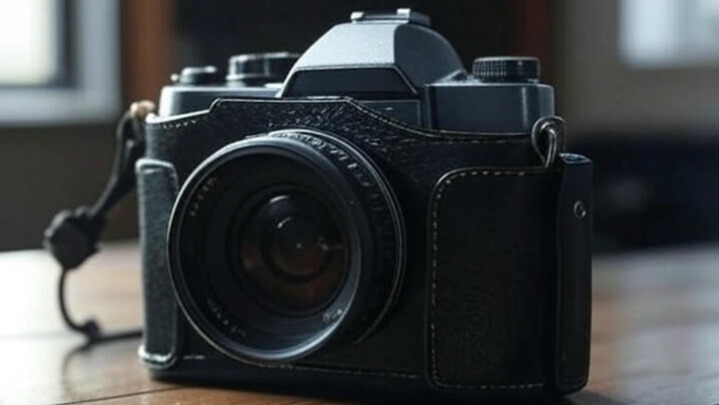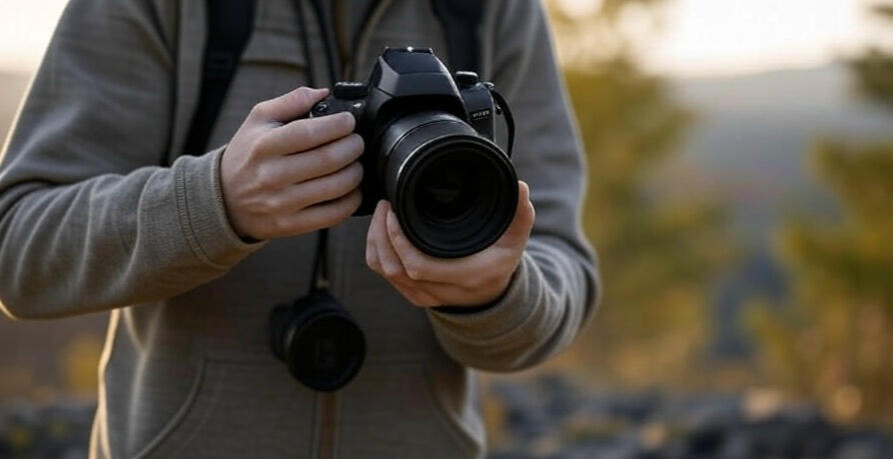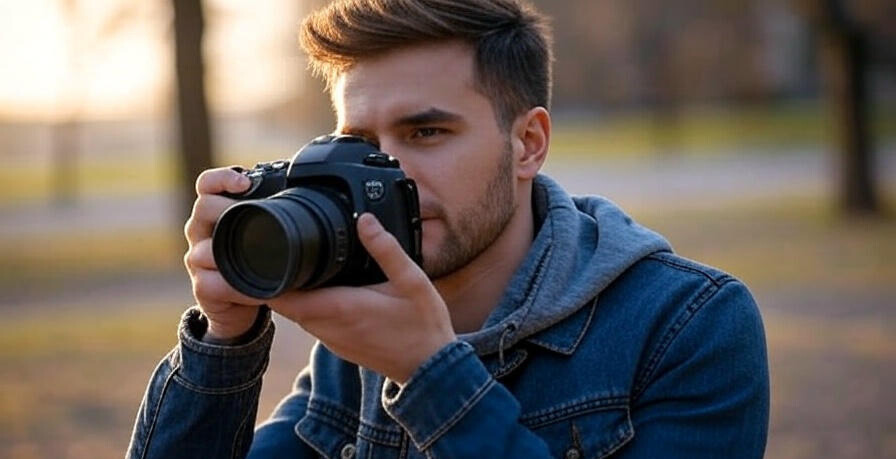Complete Beginner’s Guide to DSLR Photography: Master Camera Settings and Composition
Starting your journey in DSLR photography for beginners can feel overwhelming with countless settings, buttons, and technical terms. This comprehensive guide will transform you from a complete novice to a confident photographer who understands DSLR camera settings and creates compelling compositions. Whether you’ve just unboxed your first camera or want to move beyond auto mode, this article covers everything you need to know.
Understanding Your DSLR Camera: Essential Components
Before diving into DSLR photography settings explained, let’s familiarize ourselves with the key components of your camera. Understanding these parts will help you navigate your camera more confidently and make better creative decisions.
| Camera Component | Function | Beginner Tip |
|---|---|---|
| Viewfinder | Shows what your lens sees | Use for precise composition and manual focus |
| LCD Screen | Live view and photo review | Great for low-angle shots and video recording |
| Mode Dial | Selects shooting modes | Start with Program mode before trying Manual |
| Control Dial | Adjusts settings quickly | Practice changing settings without looking |
| Menu Button | Access camera settings | Customize function buttons for faster access |
Mastering the Exposure Triangle: Foundation of DSLR Photography
The exposure triangle is the cornerstone of manual camera settings for beginners. These three elements work together to control how light enters your camera, determining whether your photos are bright, dark, sharp, or blurry.
Aperture (f-stop): Controlling Depth of Field
Aperture in DSLR photography controls how much light enters through your lens and determines depth of field. Understanding aperture is crucial for creating professional-looking photos with beautiful background blur or sharp landscapes.
| Aperture Setting | Depth of Field | Best Uses | Example Scenarios |
|---|---|---|---|
| f/1.4 – f/2.8 | Very Shallow | Portraits, subject isolation | Wedding photos, headshots, artistic shots |
| f/4 – f/5.6 | Moderate | Group photos, street photography | Family gatherings, travel photography |
| f/8 – f/11 | Deep | Landscapes, architecture | Nature photography, real estate |
| f/16 – f/22 | Maximum | Macro, extreme landscapes | Product photography, detailed scenes |
Shutter Speed: Capturing Motion
Shutter speed in photography determines how long your camera sensor is exposed to light. This setting is crucial for freezing fast action or creating artistic motion blur effects.
| Shutter Speed | Effect | Recommended Use | Camera Support Needed |
|---|---|---|---|
| 1/1000s or faster | Freezes fast action | Sports, wildlife, children | Handheld OK |
| 1/250s – 1/500s | Stops most movement | General photography, walking people | Handheld OK |
| 1/60s – 1/125s | Slight motion blur possible | Portraits, still subjects | Steady hands needed |
| 1/30s or slower | Intentional motion blur | Water, clouds, artistic effects | Tripod required |
ISO: Managing Digital Sensitivity
ISO settings explained for beginners: ISO controls your camera sensor’s sensitivity to light. Higher ISO values allow shooting in darker conditions but introduce digital noise (grain) to your images.
| ISO Range | Image Quality | Lighting Conditions | Typical Uses |
|---|---|---|---|
| 100 – 200 | Excellent, no noise | Bright daylight | Landscapes, outdoor portraits |
| 400 – 800 | Very good, minimal noise | Overcast, indoor with windows | General photography, events |
| 1600 – 3200 | Good, acceptable noise | Indoor, evening | Available light photography |
| 6400+ | Noisy but usable | Very dark conditions | Night photography, concerts |
Camera Modes: From Auto to Manual Mastery
Understanding DSLR shooting modes helps you gradually transition from automatic settings to full creative control. Each mode offers different levels of control over your camera settings.
Beginner-Friendly Shooting Modes
| Mode | You Control | Camera Controls | Best For Learning |
|---|---|---|---|
| Program (P) | ISO, exposure compensation | Aperture and shutter speed | Understanding exposure basics |
| Aperture Priority (A/Av) | Aperture and ISO | Shutter speed | Controlling depth of field |
| Shutter Priority (S/Tv) | Shutter speed and ISO | Aperture | Capturing motion effects |
| Manual (M) | All settings | Nothing (you decide) | Complete creative control |
Photography Composition Rules: Creating Compelling Images
Photography composition techniques are as important as technical camera knowledge. Good composition transforms ordinary subjects into extraordinary photographs that capture viewers’ attention and emotion.
Essential Composition Guidelines
| Composition Rule | Description | When to Use | When to Break |
|---|---|---|---|
| Rule of Thirds | Place subjects on imaginary grid lines | Landscapes, portraits, general scenes | Symmetrical subjects, centered compositions |
| Leading Lines | Use lines to guide viewer’s eye | Architecture, roads, natural elements | When lines distract from main subject |
| Framing | Use foreground elements as natural frames | Windows, arches, tree branches | When frame overwhelms the subject |
| Symmetry & Patterns | Find repetition and balance | Architecture, reflections, nature | To create tension or draw attention |
Advanced Composition Techniques
As you develop your skills in DSLR photography for beginners, these advanced techniques will help you create more dynamic and engaging images:
- Fill the Frame: Get closer to your subject to eliminate distracting elements and create impact
- Negative Space: Use empty areas to emphasize your main subject and create breathing room
- Color Theory: Understand complementary colors and how they interact in your compositions
- Depth Creation: Use foreground, middle ground, and background elements to add dimension
- Golden Hour Magic: Shoot during the first and last hour of sunlight for warm, flattering light
Focus Systems: Achieving Sharp Images
Understanding autofocus modes and focus techniques is crucial for sharp, professional-looking photographs. Modern DSLRs offer sophisticated focusing systems that can adapt to different shooting situations.
| Focus Mode | Best For | How It Works | Pro Tips |
|---|---|---|---|
| Single Point AF | Portraits, still subjects | Uses one focus point you select | Most accurate for precise focusing |
| Dynamic AF | Moving subjects | Tracks subjects across multiple points | Great for sports and wildlife |
| Auto Area AF | Quick snapshots | Camera selects focus points | Convenient but less control |
| Manual Focus | Macro, low light, creative control | You turn the focus ring | Use live view magnification for precision |
Lighting Fundamentals: Natural and Artificial Light
Mastering light is essential for beginner DSLR photography techniques. Light shapes mood, reveals texture, and can make or break your photographs. Understanding different lighting conditions helps you adapt your camera settings accordingly.
Natural Light Scenarios
| Lighting Condition | Characteristics | Camera Settings | Best Subjects |
|---|---|---|---|
| Golden Hour | Warm, soft, directional | Lower ISO, wider apertures | Portraits, landscapes |
| Blue Hour | Even, blue-tinted light | Higher ISO, tripod needed | Cityscapes, architecture |
| Overcast | Soft, even, neutral | Standard settings work well | Portraits, macro, details |
| Harsh Sunlight | Hard shadows, high contrast | Lower ISO, smaller apertures | Architecture, strong compositions |
Common Beginner Mistakes and Solutions
Learning from common mistakes accelerates your progress in DSLR photography for beginners. Here are the most frequent issues new photographers face and practical solutions:
| Common Mistake | Why It Happens | Quick Fix | Long-term Solution |
|---|---|---|---|
| Blurry Photos | Slow shutter speed, camera shake | Use faster shutter speed or tripod | Learn proper hand-holding technique |
| Over/Under Exposure | Wrong exposure settings | Use exposure compensation | Understand exposure triangle |
| Poor Composition | Not considering foreground/background | Move around, try different angles | Study composition rules and practice |
| Noisy Images | ISO too high for conditions | Lower ISO, use wider aperture | Learn noise reduction techniques |
Essential Camera Accessories for Beginners
While your DSLR camera is the foundation, certain accessories can significantly improve your beginner DSLR photography techniques and expand your creative possibilities.
Must-Have Accessories
| Accessory | Purpose | Budget Option | Investment Priority |
|---|---|---|---|
| Tripod | Stability for sharp images | Basic aluminum tripod ($50-100) | High – Essential for many situations |
| Extra Memory Cards | Storage and backup | Class 10 SD cards ($20-40) | High – Never run out of space |
| UV/Protective Filter | Lens protection | Basic UV filter ($15-30) | Medium – Protects expensive lenses |
| Camera Bag | Protection and organization | Padded camera bag ($30-60) | High – Protects your investment |
Post-Processing Basics: Enhancing Your Images
Understanding basic post-processing complements your DSLR photography settings explained knowledge. While getting the shot right in-camera is crucial, thoughtful editing can enhance your images significantly.
Essential Editing Adjustments
- Exposure Correction: Fine-tune brightness without losing detail in highlights or shadows
- White Balance: Correct color temperature for natural-looking colors
- Contrast and Clarity: Add punch to your images and enhance local contrast
- Color Vibrancy: Enhance colors selectively without oversaturation
- Noise Reduction: Clean up high-ISO images while preserving detail
Popular editing software options include Adobe Lightroom for beginners, Adobe Photoshop for advanced editing, and free alternatives like GIMP or RawTherapee.
Building Your Photography Skills: Practice and Learning
Developing expertise in DSLR photography for beginners requires consistent practice and continuous learning. Here’s a structured approach to improve your skills systematically.
Weekly Practice Schedule
| Day | Focus Area | Practice Exercise | Expected Outcome |
|---|---|---|---|
| Monday | Aperture Control | Shoot same subject at different f-stops | Understand depth of field changes |
| Wednesday | Shutter Speed | Capture moving subjects at various speeds | Master motion control techniques |
| Friday | Composition | Apply one composition rule per session | Improve visual storytelling |
| Weekend | Creative Project | Combine all learned techniques | Build portfolio and confidence |
Conclusion: Your Journey in DSLR Photography
Mastering DSLR photography for beginners is an exciting journey that combines technical knowledge with creative expression. This comprehensive guide has covered the essential DSLR camera settings, composition techniques, and practical tips you need to start creating compelling photographs.
Remember that becoming proficient in photography takes time and practice. Start with the basics covered in this guide, focus on understanding the exposure triangle, and gradually experiment with more advanced techniques. Don’t be afraid to make mistakes – they’re valuable learning opportunities that will accelerate your growth.
Key takeaways for your photography journey:
- Master the exposure triangle (aperture, shutter speed, ISO) before moving to complex techniques
- Practice composition rules but don’t be afraid to break them creatively
- Understand your camera’s focus system for consistently sharp images
- Learn to work with different lighting conditions
- Invest in essential accessories that enhance your capabilities
- Develop a consistent practice routine for steady improvement
Whether you’re capturing family memories, exploring creative photography, or considering a professional career, these fundamental skills will serve as your foundation. Keep experimenting, stay curious, and most importantly, enjoy the process of creating images that tell your unique story.
For more photography tips, camera reviews, and creative inspiration, explore our comprehensive guides at Kashmir News. Connect with fellow photography enthusiasts and stay updated with the latest industry trends through our breaking news section.



